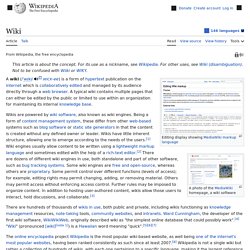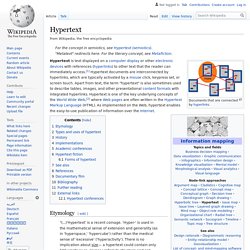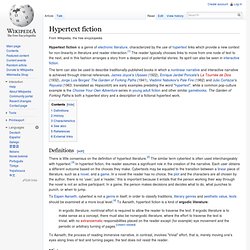

Facebook. Inspiration til Facebook i undervisningen. I modsætning alle de andre platforme vi arbejder på (Fronter, Lektio, Ludus eller hvad de nu alle sammen hedder), så er eleverne altid på Facebook, ser opslag lynhurtigt, og har sjovt nok aldrig problemer med at komme på.

Det er virkelig det sted jeg oplever som den hurtigste vej til at komme i kontakt med alle elever. Men udover at være en kontaktflade, så kan Facebook også bruges som reelt undervisningsværktøj. Her kommer 8 forslag til hvordan. 1: Brug Facebook som en vejledningsplatform. Facebook i undervisningen på Facebook. Engelskundervisere på Facebook. Funny Fake Facebook Walls - The Wall Machine. GAMES FOR LANGUAGE LEARNING. ClassTools.net: Create interactive flash tools / games for education. Facebook gruppe tutorial. Wiki. Type of website that visitors can edit A wiki ( WIK-ee) is a hypertext publication collaboratively edited and managed by its own audience directly using a web browser.

A typical wiki contains multiple pages for the subjects or scope of the project and could be either open to the public or limited to use within an organization for maintaining its internal knowledge base. Wikis are enabled by wiki software, otherwise known as wiki engines. The online encyclopedia project, Wikipedia, is the most popular wiki-based website, and is one of the most widely viewed sites in the world, having been ranked in the top twenty since 2007.[3] Wikipedia is not a single wiki but rather a collection of hundreds of wikis, with each one pertaining to a specific language. In addition to Wikipedia, there are hundreds of thousands of other wikis in use, both public and private, including wikis functioning as knowledge management resources, notetaking tools, community websites, and intranets.
Characteristics. Wikis for Everyone - Wikispaces. Introduction to Wikispaces. Hypertext. Text with references (links) to other text that the reader can immediately access Engineer Vannevar Bush wrote "As We May Think" in 1945 in which he described the Memex, a theoretical proto-hypertext device which in turn helped inspire the subsequent invention of hypertext.

Etymology[edit] "(...)'Hypertext' is a recent coinage. 'Hyper-' is used in the mathematical sense of extension and generality (as in 'hyperspace,' 'hypercube') rather than the medical sense of 'excessive' ('hyperactivity'). The English prefix "hyper-" comes from the Greek prefix "ὑπερ-" and means "over" or "beyond"; it has a common origin with the prefix "super-" which comes from Latin. Hypertext fiction. Hypertext fiction is a genre of electronic literature, characterized by the use of hypertext links which provide a new context for non-linearity in literature and reader interaction.[1] The reader typically chooses links to move from one node of text to the next, and in this fashion arranges a story from a deeper pool of potential stories.

Its spirit can also be seen in interactive fiction. Definitions[edit] To Espen Aarseth, cybertext is not a genre in itself; in order to classify traditions, literary genres and aesthetic value, texts should be examined at a more local level.[4] To Aarseth, hypertext fiction is a kind of ergodic literature: In ergodic literature, nontrivial effort is required to allow the reader to traverse the text. To Aarseth, the process of reading immersive narrative, in contrast, involves "trivial" effort, that is, merely moving one's eyes along lines of text and turning pages; the text does not resist the reader. History[edit] Caitlin Fisher: These Waves of Girls. Video: RSS in Plain English. RSS Tutorial. Create your free Blog.
How To Create a Google Account. Step by Step Lesson on how to Create a Blog on Blogger com. Blogger Tutorial Pt. 1. Assorted Stuff: Tech in Learning - ideer til brugen af blogs. Blogs are primarily about writing.

But within that broad category there are many ways that blogging can be used with students to improve their learning in almost any subject area. Teachers can also use blogs for a variety of purposes. Here are just a few ideas with more coming. Blogs by students Journals – Many English teachers (and those in other subjects) require their students to write regular journal entries. Book reports, literature circles – Students often are expected to summarize and react to books and other materials they’ve read. Creative writing assignments, short stories, poetry – A blog can be a great way to showcase student writing, again with the options for other students and even parents to comment on the work.
Display and discussion of student art work/photography – since pictures, video and audio can be embedded within a blog post, showcasing student work doesn’t have to be limited to their writing. Edte.ch - ideer til brugen af blogs. 111 variationer til undervisning - ideer til brugen af blogs. Så lufter jeg ideerne selvom jeg ikke selv har prøvet dem af endnu.

Måske sidder der nogen derude, som kan fortælle mig om jeg er helt på vildspor og rette eventuelt rette mig, inden jeg går igang med noget der er helt ude i hampen. Den store forkromede plan er at få mine kommende 1.g'er (dansk) til at oprette blogs. Ja, alle elever i klassen og dansklæreren opretter blogs, og opretter rss-feeds til alle de andre blogs på deres egen blog.
Jessica Westhead: And Also Sharks.